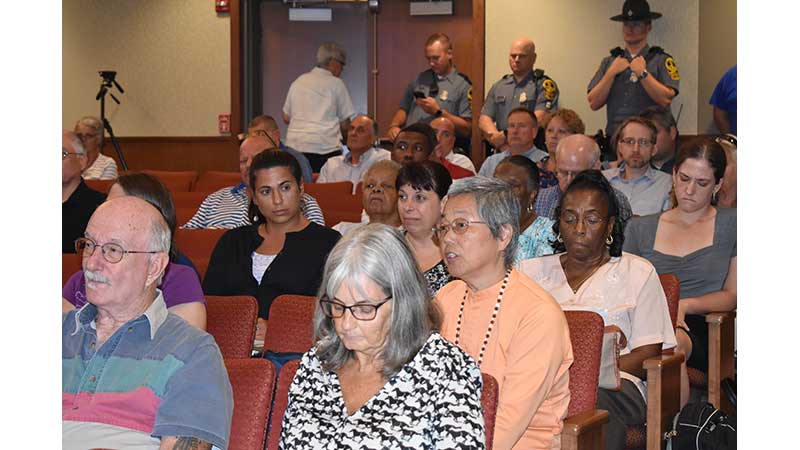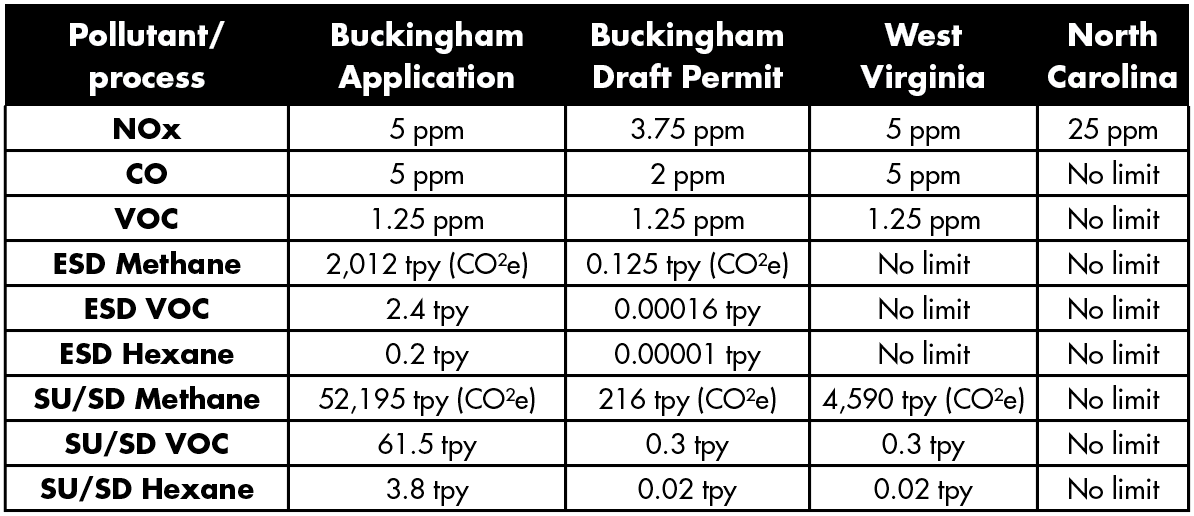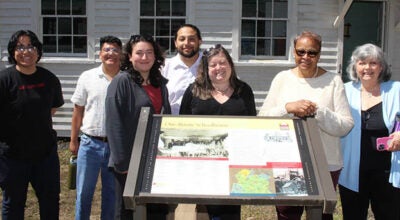VDEQ presents on permit
Published 6:55 am Wednesday, August 22, 2018
A meeting Thursday at the Buckingham County Peter Francisco Auditorium offered an overview of and some answered questions relating to an air quality permit and engineering analysis from the Virginia Department of Environmental Quality (VDEQ) State Air Pollution Control Board in reference to the Atlantic Coast Pipeline (ACP) compressor station, proposed to be located off Route 56 in Buckingham.
The air permit for the compressor station is considered a minor New Source Review (NSR) air permit, a title designated for facilities where uncontrolled emissions of equipment and process units are above exemption levels detailed by the VDEQ.
The permit included 51 requirements for the compressor station, including that the operations practice proper emission controls, that equipment be installed with the proper monitoring devices, that the appropriate fuel be used and regulated, that the emissions fall within the necessary limits and be properly tested and evaluated.
Members of the community and others concerned about the ACP held a gathering outside of the administration office before the meeting. Representatives of the VDEQ stood by the front doors, asking participants to leave bags in their vehicles, and remove any signage or clothing with messages about the pipeline debate, including bandanas.
Michael Dowd, director of Air Division, spoke during the meeting and said the office only focuses on air quality, and cannot look at other factors such as noise or land use.
Dowd said in order to approve the permit, the department has to guarantee two things: that the applicant has to install the best air control technology available, and said the office cannot issue a permit unless the organization demonstrates that emissions do not exceed health-based air standards.
“We believe the proposed Buckingham County compressor station permit meets both tests with flying colors,” Dowd said. “If enacted and issued by the state air pollution control board, we believe this permit would be the most stringent ever issued to a compressor station.”
Patrick Corbett, air toxics coordinator, gave the presentation describing the process in which VDEQ would model and test to determine the potential toxic emissions that would come from the proposed compressor station, and whether the emissions meets the state and federal regulations.
Since the compressor station has not been built, the figures and numbers of air emissions used in the presentation are based on calculations formulated and modeled from figures in the permit application.
Corbett said the turbines are central to the compressor station, burning natural gas and mixing it with air. He described them as large fans that travel through a shaft that leads into the pipeline and pushes the gas through the pipeline.
Corbett said gases and material that is created as a result of gas moving through the compressor station include main pollutants nitrogen oxides (NOx), carbon monoxide (CO), and lesser matters of particulate include volatile organic compounds (VOC), formaldehyde and particulates that are measured 10 micrometers or less in diameter (PM10) and PM 2.5, measuring 2.5 or less in diameter.
Formaldehyde is also considered one of the largest air toxic hazardous air pollutant.
Corbett said natural gas typically contains 2.6 VOCs, 0.16 percent hexane and 88 percent methane.
He said equipment leaks, emissions from pigging (a series of machines used to maintain the pipeline), starting up and shutting down the compressor tubes and emissions from emergency system testing are among the factors that contribute to natural gas becoming released.
He said inspecting and minimizing piggings and compressor start ups and shutdowns could prevent natural gas leakage.
Corbett said in comparison to gas pipelines in West Virginia and North Carolina, pollutant amounts for the Buckingham compressor station are more stringent.
The presentation for the Buckingham application cited that the allowance for NOx and CO are 5 parts per million (ppm), a low concentration of a solution.
This compares with West Virginia and North Carolina, which reportedly allows 5 ppm and 25 ppm respectively.
For VOC and Hexane, the allowance is 2.4 and 0.2 Tons Per Year (tpy) in the Buckingham application, with reportedly no limits in West Virginia and North Carolina. As defined by the VDEQ, tpy is a long-term mass emission rate.
For the air quality analysis, Corbett said they measure pollutant dispersion within a one-hour period and within one year.
Corbett said the output from the proposed compressor station, based on the calculations from the permit applications, would meet the standards presented by VDEQ.
Corbett said in order to test emissions of air quality and air toxins, they modeled the test results using the worst-case scenarios for emissions, such as testing as though the temperature outside is 0 degrees Fahrenheit, when the compressor station is least likely to perform well.
Corbett said what is expected to happen is that outside of the fenceline for the proposed compressor station, impacts of the toxic emissions would reportedly lessen. He said the air standards used to test the facility are based on Virginia’s health-based standards.
When modeling air toxins, Corbett said they measured the one-hour formaldehyde emission, the annual formaldehyde emissions and the one-hour hexane standard. He said those two pollutants were the only ones that exceeded exemption thresholds, which are measured on a pollutant by pollutant basis. But he said those three models measured below the Significant Air Ambient Concentration (SAAC), the standard used by VDEQ to measure ambient air quality.
During the question and answer period, a representative from Virginia Public Radio asked if testing would only take place every two years.
Corbett said testing of actual emissions out of the pipe would take place every two years. In between those two years, Dominion officials will monitor the operation of the turbine and report findings to the VDEQ. When asked if this could potentially allow for manipulation from Dominion, Corbett said manipulations would be criminal offenses.
In the event there are violations, Corbett said there are enforcement processes that includes notifying Dominion of a violation and taking steps to correct the violations as soon as possible.
“The key goal is to get them in compliance quickly,” Corbett said.
Penalties of violations include fines of $32,500 a day, and depending on the severity of the violation, referring cases to the Attorney General’s Office.
A member of the audience asked if the VDEQ office could monitor the compressor station via a live feed.
Corbett said a process like that has not been done before. He said the current monitoring system uses advanced computers. He said they could come to the station every six months.
Nelson Bailey asked how much gasoline is deposited in buckets when the pig passes through the pipeline.
“It’s collected in a 5-gallon bucket,” Corbett said. “It’s not a very large amount.”
Swami Dayananda asked if the air pollutant studies conducted by VDEQ look at the combination of pollutants, and if they become more toxic when exposed to the air and with different pollutants. Dayananda also asked about the air model analysis the VDEQ performed and air dispersion model, which examines the weather and seasonal pattern.
About the air model analysis, Corbett said those tests are the same, and look at the pollutants in relation to the weather. He said the test examines the science of each pollutant, but not in combination.
“We regulate to the standards that are there,” Dowd said. “With respect to this compressor station, there are only two that are emitted in any number of concern. The rest of the pollutants just aren’t relevant to the combustion process or to the pipeline gas here.”
Ella Rose, who lives by the compressor station site, asked why members of the community are doing their own air quality monitoring tests.
Corbett said VDEQ has a air monitoring network in Virginia that tests the quality of the air.
Dowd said the equipment is expensive and that they do not have the number of test sites that they would like. He estimated the closest monitoring site is located in Charlottesville.
Chad Oba brought a list of 107 questions compiled by her and other community members and gave it to Corbett, Dowd and Tamera Thompson, manager with the Office of Air Permitting after the meeting. She thanked the board for coming.
Oba noted that while the VDEQ has had time to review the application, members of the community and those who would be most affected by it only had less than three weeks to read the application and engineer analysis, understand it and formulate questions without the experience and knowledge that those in the VDEQ had. She asked the board for more time, and to give citizens more equal footing in the process.
“It doesn’t seem like it’s been a level playing field,” Oba said.
She said community members generated 98 signatures requesting for a quantified risk assessment.
“We’re not really completely satisfied that that’s really indeed going to protect our health,” Oba said about the air permit, and asked the air board to potentially work with other organizations involved with the pipeline to get a more complete assessment of the impact the compressor station could have on those who live closest to it.
Corbett said the public comments and questions from the audience would not be counted in the public comment period the VDEQ is holding for the permit.
The public comment period began Aug. 8 and continues until Sept. 11, where the VDEQ will hold a hearing and take in-person comments at Buckingham County Middle School from 5-9:30 p.m., or until all public comment has been received. Participants must sign up in person to speak during the hearing and can speak for up to three minutes.
After the meeting and after each public comment has been reviewed, the VDEQ would decide whether to approve the permit or not.
The comments must include the names, mailing addresses and telephone numbers of the commenter/requester and of all persons represented by the commenter/requester. The applicant name and registration number for the compressor station is Atlantic Coast Pipeline, LLC; 21599.
Ann Regn, the VDEQ contact for the permit, can be reached at (804) 698-4442; Piedmont Regional Office, RE: Buckingham Compressor Station, 4949-A Cox Road, Glen Allen, VA 23060; airdivision1@deq.virginia.gov and by fax at (804) 527-5106.







